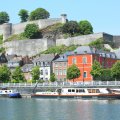Citadel of Namur, one of the most important in Europe, with multiple underground passages, defense galleries, attack galleries
Spread over 8 hectares of greenery, the Namur citadel is one of the largest in Europe. The citadel is strategically located, with numerous underground passages, defense galleries, attack galleries and bombing galleries. Overlooking the town on a 190-metre-high rocky spur, the citadel dominates the confluence of the Sambre and Meuse rivers and the two valleys: the fortifications enjoy a splendid view. Considered a dominant position in the Middle Ages, the citadel was developed over the centuries to become a stronghold envied by all the powers that ruled the region. It is divided into three strata: Logis comtal at the bottom, Médiane in the middle and Terra Nova at the top.
The Namur Citadel can be explored on foot from the town center (it is signposted), by little train, by tuk-tuk and, from spring 2021, by cable car! The monumental sculpture Searching for Utopia represents a giant golden turtle topped by a human. Visible from afar and popular with photographers, it has decorated the garden since 2015.
Terra Nova and underground tour. The Terra Nova Visitor Center is a good starting point for understanding the history of the site. The floating wall of screens and images lets you immerse yourself in maps and videos, images and sound testimonies. A visit to the 500 meters of underground passages is highly recommended, enhanced by 3D projections and sound effects. The tour is immersive, interactive and fun for children and adults alike. Alongside the Terra Nova Center, the building houses a cafeteria serving snacks and quality local produce to take home as a souvenir or enjoy on site.
Visit the perfume factory. Inside the citadel, the perfume workshop is a must-see. This creative center, the only one of its kind in Northern Europe, explains the various stages involved in creating a natural, hand-crafted perfume. The guided tour or audioguide lasts 1 hour. We explore the laboratories before entering the composition room, a 16th-century casemate from the time of Charles V, where the perfumer's famous organ case is located, and where scents are mixed. Next come the maceration galleries, where perfumes mature for six months. And finally, the olfactorium, where you can test the different fragrances.
Other points of interest on the site include the stade des Jeux, various walks and the Tour du guetteur.
History. As early as the 1st century, a port existed at the Pointe de Grognon, and the inhabitants maintained trade relations with the rest of the Roman Empire, as attested by coins found on the site. Between the5th and 10th centuries, activity in the port intensified and the town built its first ramparts. It became a military stronghold for the next ten centuries, during the medieval period. The château was joined by the collegiate church of Saint-Pierre and canons' dwellings, as religion took on great importance in society during this period. From the 10th to the 15th century, twenty-two counts succeeded one another, ruling from the citadel as the capital of the County of Namur. Some of them came from Hainaut, France and Flanders. Some proved more conquering and daring than others, with Count Baudouin II de Courtenay even going on to become Emperor of Constantinople! Blue blood wasn't afraid of shifting power! Yolande de Courtenay became Queen of Hungary and Blanche de Namur Queen of Sweden. It was during this period that the town prospered, grew and fortified. By the 15th century, it had 8,000 inhabitants. It was Jean III, the last Count of Namur, who, ruined and without an heir, sold it to Philippe le Bon, Duke of Burgundy, in 1421.
During the conflict-ridden period of imperial conquest between the 15th and 19th centuries, the citadel and the town of Namur underwent a spectacular transformation into a massive stronghold, notably through the construction of a belt of nine forts. The citadel's underground network was so extensive that Napoleon I dubbed it the termite mound of Europe! These constituted an underground military base, where an army could subsist for a month. Taken and retaken by various conquerors, it was the object of much covetousness. The battles and sieges that took place here kept pace with the evolution of weapons and warfare. As catapults propelled cannonballs farther and farther, the citadel expanded to remain untouchable! The loopholes, beer stores (the water could be infected with bacteria, but never the beer!), cereal stores, weapon rooms and various overhead and underground sections were long an example of military organization. It passed under the rule of the Holy German Empire, then the Habsburgs of Spain and Austria, before being taken over by the French Republic and Napoleon's French Empire (it was redesigned by Vauban) and finally by the Netherlands. Peace was not restored until Belgium became independent in 1830. At the beginning of the 19th century, it still had a population of 20,000. Finally, Leopold II decided to partially demilitarize it in 1891.
The Namur citadel served as a guard cellar for wine merchant and breeder Grafé-Lecocq.
Did you know? This review was written by our professional authors.
Book the Best Activities with Get Your Guide
Members' reviews on NAMUR CITADEL
The ratings and reviews below reflect the subjective opinions of members and not the opinion of The Little Witty.
Find unique holiday offers with our partners






